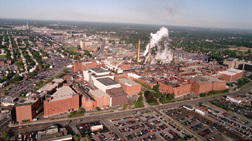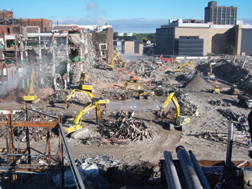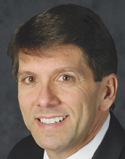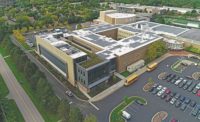 Eastman Kodak Co Kodak Park housed an aging infrastructure on a brownfield site.
|
When the Eastman Kodak Co. decided to implement a $200-million, 13.5-million-sq-ft footprint-reduction program (FRP) at Kodak Park in Rochester N.Y., it turned to design-build with a difference. Using electronic bidding coupled with sealed bids or reverse auctions, over 150 contractors have successfully delivered 1,600 contracts covering everything from asbestos abatement, building demolition, environmental remediation, utility relocation, build-outs and site restoration in the four-year program.
“We retained and improved our infrastructure and we now have a campus-like site that can attract new tenants and new revenue to offset the shrinking film business,” says David P. Stoklosa, director of Kodak’s Rochester facilities. Kodak in 2004 selected LeChase Construction Services LLC, Rochester, to manage the program, which calls for demolishing or preparing for sale 60 buildings on the 1,300-acre industrial complex. To date 48 structures, totaling 5.8 million sq ft, have been leveled and another 12 buildings, totaling 7.7 million sq ft have been or will be sold. Additionally, two 350-ft-tall stacks and 12 cooling towers were demolished and two powerplants upgraded into one 130-Mw combined-cycle plant that generates cooling, heating and electricity. More than 28 tenants now occupy new or revitalized office or manufacturing space at the park.
|
“This has been touted by everyone in our organization as an extremely successful program,” says Edward C. Slovak, Kodak FRP program manager. “We had to finish in December 2007 and it was crystal clear to everyone that was a real date.” Says Richard A. Staples, Kodak commodity manager for capitol services, “The FRP was instrumental in achieving our transformation from the traditional silver halide film business to the new digital marketplace. Reducing the infrastructure and operating cost at Kodak Park allows us to grow our digital business.”
For 116 years Kodak had processed photo film and made photographic chemicals and equipment at Kodak Park. But the digital age changed all that. To help Kodak rightsize and reorient, LeChase was selected over three other bidders through an e-procurement process Kodak adopted in the late 1990s.
 David p. Stoklosa Over 48 structures, totaling 5.8 million sq ft, were leveled as part of Kodak�s $200-million footprint reduction program in Rochester.
|
As design-builder, LeChase was charged with delivering office and manufacturing space renovations, manufacturing operation relocations, overhead and underground utilities, process piping, telecommunication and high-voltage electrical relocations as well as complete new roadway and parking, and site restoration. To do so, the firm teamed with five local engineering and architectural firms on a percentage-based fee system to provide design and consulting services.
“After several days of strategizing and calculating, the firms presented a fee matrix that accounted for all anticipated types of work, in multiple-dollar thresholds at a very competitive rate,” says Richard A. Laudisi, LeChase vice president. “As projects were released to us we assigned the engineering to the firm that had the expertise, key personnel and/or familiarity with the work to be executed and at a cost pulled off the matrix.”
After reviewing different procurement strategies, Kodak chose Procuri, which provided the film giant with an e-procurement tool for global procurement needs. Procuri Inc., Atlanta, an on-demand supply-management firm, was acquired by Sunnyvale, Calif.-based Ariba last year for $93 million.
“There was evidence in the procurement industry that owners and users would greatly benefit from the e-procurement process,” says Staples. “Essentially we were trying to drive down costs while delivering all services and products, everywhere there was a fit, on a competitive basis. We use it to buy hard commodities, trucking, chemicals; Anything that can be purchased the traditional way can be purchased through Procuri. Procurement options include reverse auctions, sealed bids and receiving request for proposals. In many cases our transactions and communications are primarily paperless.”
 | LeChase is working the process into its procurement operations. — Richard A. Laudisi, Vice President, LeChase Construction Services
|
Kodak trains and prequalifies preferred contractors and suppliers for the process. Several weeks of training in the system and application of tactics brought the LeChase team to full competency.
LeChase executed the e-bid process, made the awards and held all contracts for the FRP. But every contract was linked to another. “A demo project could typically involve several A/E firms pulling together bid documents as well as designing the renovation and relocation package, and utility work well before the demo goes out to bid,” says Laudisi.
The system can be used on any Internet-connected computer and requires a license. Procuri’s password-protected Website is divided into buyers and sellers and maintains data-base storage. Subcontractors need no special software. Once logged on everything is completed from the project dashboard. The system provides ...
 Related Link:
Related Link: 

Post a comment to this article
Report Abusive Comment